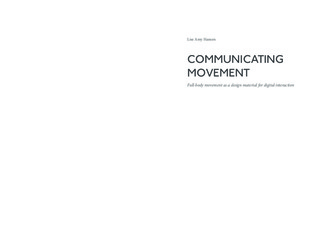| dc.description.abstract | Today, our movements are increasingly informed and influenced, shifted and shaped by a digitised environment. The aim of this thesis has been to explore and present a creative potential in conceptualising full-body movement and movement data for digital interaction. I was motivated by the expressive and performed movements that we observe and act upon in interpersonal communication to identify a potential in digital interaction. I use concepts and intermediary digital tools as a way to both explore and communicate full-body movement as a design material, that is, as a communicative resource for meaning-making in digital interactions. I take a communicative approach and adopt a Social Semiotics framework. I discuss how corporeal qualities are in part expressed through our movement dynamics in that movement requires a body and this body is aged, gendered, cultured and conditioned as well as sensate, expressive and performed. I explore how to address such notions through their visual form, by way of abstracted data, represented in dynamic visualisations. My argument is that there are creative and pivotal decisions in how we materialise movement and movement data for design.
I draw on choreographic research and digital tools to position movement in design and I propose the concepts of Accessibility, Immediacy and Generation as central for how movement needs to be visualised for interaction design. I suggest a textual conceptualisation of movement dynamics in a Movement Schema, where I identify Velocity, Position, Repetition and Frequency as modalities that address how we use movement dynamics to communicate.
I further explore dynamics in movement data by way of design investigations in collaborative workshops with interaction designers Hellicar&Lewis. We created a digital application, Sync, which allows for dynamic visualisations of movement data. I also devised the concepts of Malleability, Visuality and Ambiguity highlighting creative considerations in handling movement data.
My motivation for naming and conceptualising movement is to understand how movement can be made to matter for design. By making a case for
movement and movement data as a creative material for a designer, I place a focus on movement scripts, that run and increasingly perforate our surroundings, informing and altering our movements. Corporeal qualities may be made creatively available through materialising acts such as through digital tools for the dynamic visualisations of movement data. By unfolding the concerns of the various stages of materialising movement, designers can consider the role of movement at a conceptual level and in turn enable interactions to be built that are informed by a critical view on movement and, by extension, the role of our bodies. | nb_NO |
